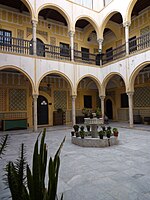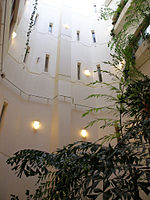| Revision as of 04:49, 24 November 2013 editDooURWAnKyNoo6dle (talk | contribs)3 edits →Relevance to the architecture of today← Previous edit | Revision as of 04:52, 24 November 2013 edit undoEvergreenFir (talk | contribs)Autopatrolled, Administrators129,582 editsm Reverted 2 edits by DooURWAnKyNoo6dle (talk) to last revision by ClueBot NG. (TW)Next edit → | ||
| Line 26: | Line 26: | ||
| The medieval European farmhouse embodies what we think of today as one of the most archetypal examples of a courtyard house—four buildings arranged around a square courtyard with a steep roof covered by thatch. The central courtyard was used for working, gathering, and sometimes keeping small livestock. An elevated walkway frequently ran around two or three sides of the courtyards in the houses. Such structures afforded protection, and could even be made defensible. | The medieval European farmhouse embodies what we think of today as one of the most archetypal examples of a courtyard house—four buildings arranged around a square courtyard with a steep roof covered by thatch. The central courtyard was used for working, gathering, and sometimes keeping small livestock. An elevated walkway frequently ran around two or three sides of the courtyards in the houses. Such structures afforded protection, and could even be made defensible. | ||
| In the first half of the 20th century, a trend developed in ] around Courtyard houses. Designers such as the Davis family and the Zwebell family developed houses that only visually appeared to mimic Mediterranean architecture, but using very carefully planned courtyards managed to create both a sense of community, safety and scale. Using various levels of private/public gradations these courtyard houses were so successful that they have been copied throughout the western coast of the United States. They are so typical for Los Angeles that several television series were recorded in them, among others, '']''. |
In the first half of the 20th century, a trend developed in ] around Courtyard houses. Designers such as the Davis family and the Zwebell family developed houses that only visually appeared to mimic Mediterranean architecture, but using very carefully planned courtyards managed to create both a sense of community, safety and scale. Using various levels of private/public gradations these courtyard houses were so successful that they have been copied throughout the western coast of the United States. They are so typical for Los Angeles that several television series were recorded in them, among others, '']''. | ||
| == Relevance to the architecture of today == | |||
| Triangle | |||
| More and more, architects are investigating ways that courtyards can play a role in the development of today's homes and cities. In densely populated areas, a courtyard in a home can provide privacy for a family, a break from the frantic pace of everyday life, and a safe place for children to play. With space at a premium, architects are experimenting with courtyards as a way to provide outdoor space for small communities of people at a time. A courtyard surrounded by 12 houses, for example, would provide a shared park-like space for those families, who could take pride in ownership of the space. Though this might sound like a modern-day solution to an inner city problem, the grouping of houses around a shared courtyard was common practice among the ] as far back as the 13th century{{Citation needed|date=April 2010}}. | |||
| In ], the floor plans of "marina style" houses often include a central ], a miniature version of an open courtyard, sometimes covered with glass or a translucent material. Central patios provide natural light to common areas and space for potted outdoor plants. In Gilgit/Baltistan, Pakistan, courtyards were traditionally used for public gatherings where village related issues were discussed. These were different from jirgahs, which are a tradition of the tribal regions of Pakistan. | |||
| ==Enclosed spaces, courtyards== | ==Enclosed spaces, courtyards== | ||
| <gallery widths="200px" heights="200px" perrow="5"> | <gallery widths="200px" heights="200px" perrow="5"> | ||
Revision as of 04:52, 24 November 2013
For other uses, see Courtyard (disambiguation).

A court or courtyard is an enclosed area, often a space enclosed by a building that is open to the sky. These areas in inns and public buildings were often the primary meeting places for some purposes, leading to the other meanings of court. Both of the words "court" and "yard" derive from the same root, meaning an enclosed space. See yard and garden for the relation of this set of words.
Historic use of courtyards

Courtyards—private open spaces surrounded by walls or buildings—have been in use in residential architecture for almost as long as people have lived in constructed dwellings. The earliest known courtyard houses were built in Iran and China and date as far back as 3000 BC. Courtyards have historically been used for many purposes including cooking, sleeping, working, playing, gardening, and even places to keep animals.
Before courtyards, open fires were kept burning in a central place within a home, with only a small hole in the ceiling overhead to allow smoke to escape. Over time, these small openings were enlarged and eventually led to the development of the centralized open courtyard we know today. Courtyard homes have been designed and built throughout the world with many variations.
Courtyard homes are more prevalent in temperate climates, as an open central court can be an important aid to cooling house in warm weather. However, courtyard houses have been found in harsher climates as well for centuries. The comforts offered by a courtyard—air, light, privacy, security, and tranquility—are properties nearly universally desired in human housing.
Comparison of courtyard houses throughout the world

Ur, 2000 BC — two-storey houses constructed around an open square were built of fired brick. Kitchen, working, and public spaces were located on the ground floor, with private rooms located upstairs.
The central uncovered area in a Roman domus was referred to as an atrium. Today, we generally use the term courtyard to refer to such an area, reserving the word atrium to describe a glass-covered courtyard. Roman atrium houses were built side by side along the street. They were one-storey homes without windows that took in light from the entrance and from the central atrium. The hearth, which used to inhabit the centre of the home, was relocated, and the Roman atrium most often contained a central pool used to collect rainwater, called an impluvium. These homes frequently incorporated a second open-air area, the garden, which would be surrounded by Greek-style colonnades, forming a peristyle. This created a colonnaded walkway around the perimeter of the courtyard, which influenced monastic structures centuries later.
Courtyard houses in the Middle East reflect the nomadic influences of the region. Instead of officially designating rooms for cooking, sleeping, etc., these activities were relocated throughout the year as appropriate to accommodate the changes in temperature and the position of the sun. Often the flat rooftops of these structures were used for sleeping in warm weather. In some Islamic cultures, private courtyards provided the only outdoor space for women to relax unobserved.

The traditional Chinese courtyard house, e.g., siheyuan, is an arrangement of several individual houses around a square. Each house belongs to a different family member, and additional houses are created behind this arrangement to accommodate additional family members as needed. The Chinese courtyard is a place of privacy and tranquility, almost always incorporating a garden and water feature. In some cases, houses are constructed with multiple courtyards that increase in privacy as they recede from the street. Strangers would be received in the outermost courtyard, with the innermost ones being reserved for close friends and family members.

In a more contemporary version of the Chinese model, a courtyard can also can be used to separate a home into wings; for example, one wing of the house may be for entertaining/dining, and the other wing may be for sleeping/family/privacy. This is exemplified by the Hooper House in Baltimore, Maryland.
The medieval European farmhouse embodies what we think of today as one of the most archetypal examples of a courtyard house—four buildings arranged around a square courtyard with a steep roof covered by thatch. The central courtyard was used for working, gathering, and sometimes keeping small livestock. An elevated walkway frequently ran around two or three sides of the courtyards in the houses. Such structures afforded protection, and could even be made defensible.
In the first half of the 20th century, a trend developed in Los Angeles around Courtyard houses. Designers such as the Davis family and the Zwebell family developed houses that only visually appeared to mimic Mediterranean architecture, but using very carefully planned courtyards managed to create both a sense of community, safety and scale. Using various levels of private/public gradations these courtyard houses were so successful that they have been copied throughout the western coast of the United States. They are so typical for Los Angeles that several television series were recorded in them, among others, Melrose Place.
Relevance to the architecture of today
More and more, architects are investigating ways that courtyards can play a role in the development of today's homes and cities. In densely populated areas, a courtyard in a home can provide privacy for a family, a break from the frantic pace of everyday life, and a safe place for children to play. With space at a premium, architects are experimenting with courtyards as a way to provide outdoor space for small communities of people at a time. A courtyard surrounded by 12 houses, for example, would provide a shared park-like space for those families, who could take pride in ownership of the space. Though this might sound like a modern-day solution to an inner city problem, the grouping of houses around a shared courtyard was common practice among the Incas as far back as the 13th century.
In San Francisco, the floor plans of "marina style" houses often include a central patio, a miniature version of an open courtyard, sometimes covered with glass or a translucent material. Central patios provide natural light to common areas and space for potted outdoor plants. In Gilgit/Baltistan, Pakistan, courtyards were traditionally used for public gatherings where village related issues were discussed. These were different from jirgahs, which are a tradition of the tribal regions of Pakistan.
Enclosed spaces, courtyards
-
 Daisen-in, a sub-temple of Daitoku-ji, one of the five most important Zen temples of Kyoto.
Daisen-in, a sub-temple of Daitoku-ji, one of the five most important Zen temples of Kyoto.
-
 Rome, Italy, a courtyard
Rome, Italy, a courtyard
-
 Saint-Émilion's Romanesque ruins
Saint-Émilion's Romanesque ruins
-
 City Palace, Udaipur
City Palace, Udaipur
-
 Tripoli, the Karamanli House
Tripoli, the Karamanli House
-
 Interior of the ING Building, Edmonton, Canada.
Interior of the ING Building, Edmonton, Canada.
-
 The courtyard and the pool in Rakib-khaaneh mansion in Isfahan, Iran
The courtyard and the pool in Rakib-khaaneh mansion in Isfahan, Iran
-
Central patio in Buenos Aires, Antonio Ballvé Penintetiary Museum
See also
- Belcourt Castle, in Newport, Rhode Island
- Buckingham Palace in London, England
- Trinity Great Court, in Trinity College, Cambridge
- Atrium
- Cloister
- Cour d'honneur
- Patio garden
- Peristyle
- Quadrangle
- Traditional Arabic courtyard, Sahn
- Hooper House
- Nalukettu
- Siheyuan
References
- Tim McNeese (1999), History of Civilization - The Ancient World, Lorenz Educational Press, p. 10 ISBN 9780787703875
- Atrium: Five Thousand Years of Open Courtyards, by Werner Blaser 1985, Wepf & Co.
- Atrium Buildings: Development and Design, by Richard Saxon 1983, The Architectural Press, London
- A History of Architecture, by Spiro Kostof 1995, The Oxford Press.
| Rooms and spaces of a house | |
|---|---|
| Shared rooms | |
| Private rooms | |
| Spaces | |
| Technical, utility and storage |
|
| Great house areas | |
| Other | |
| Architectural elements | |
| Related | |